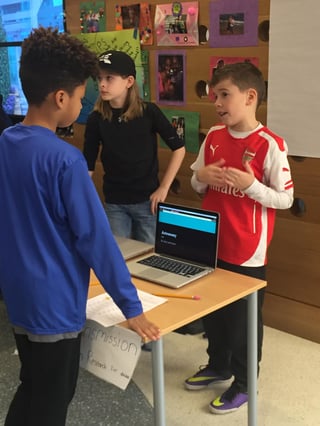WHY FEEDBACK FROM PEERS HELPS STUDENTS LEARN
April 26, 2017 admin Education, GEMS World Academy Chicago, International Baccalaureate, Peer Feedback, Collaboration
GEMS World Academy Chicago provides numerous opportunities for peer feedback. One notable example is the exhibition that formally ends the Primary Years Program, which is the first phase of the International Baccalaureate curriculum in place at GEMS. In this exhibition, fifth-graders present to the school community projects that have explored real-life issues. At each station, a sheet allows student observers to provide feedback about the effectiveness of the project and their peers' presentation of it.
Peer feedback is also a big part of the "writer's workshop" program at GEMS. Students regularly han d writing projects to classmates for constructive review. The writers then revise their work in response to the feedback. Numerous other examples abound.
d writing projects to classmates for constructive review. The writers then revise their work in response to the feedback. Numerous other examples abound.
"Giving and receiving feedback is a skill we introduce with our youngest students, framed within the IB Learner Profile," said Eila Kvaran, the IB and innovation leader at GEMS. "We ask them: 'Is your feedback caring?' 'Are you being a good communicator?' With our older learners, we focus on the actionability and constructive nature of the feedback, as well as how the receiver is able to reflect on, apply and process the feedback to improve his or her work."
Kim Wargo, the head of school at GEMS World Academy Chicago, added that learning to accept and respond to constructive feedback is an important life skill.
"Students gain confidence and resilience through learning how to receive critical and constructive feedback," she said. "Likewise, learning how to give feedback is essential to the creation of communication skills needed in today's world."
When students are able to see how they are doing from the perspective of their peers, it can serve as a motivator to improve in areas in which they are struggling. This Edutopia video shows how a positive, constructive peer-feedback program at one school inspires its students to improve their work. As long as the parameters of peer review are clearly defined — that is, students are encouraged to help each other rather than to judge one another— a collaborative environment can be fostered. Students will be inspired to help other students because they will realize that they will all win together.
Educators have noticed similar benefits in peer tutoring programs, where students actually take the responsibility to teach their classmates. One joint study from Vanderbilt University and Stanford University shows that the peer-tutoring process benefits both "sides" — the tutor and the student receiving the help. The act of tutoring becomes a learning experience for all.
Peer feedback offers a variety of benefits for students regardless of their grade level. When you give students the opportunity to interact with their peers and receive feedback from them, they are able to gain a better perspective on how they are doing from the point of view of someone who is going through a similar experience. It also gives students the chance to connect with others and gain the respect of their peers. By taking advantage of peer feedback, students are able to improve their learning.